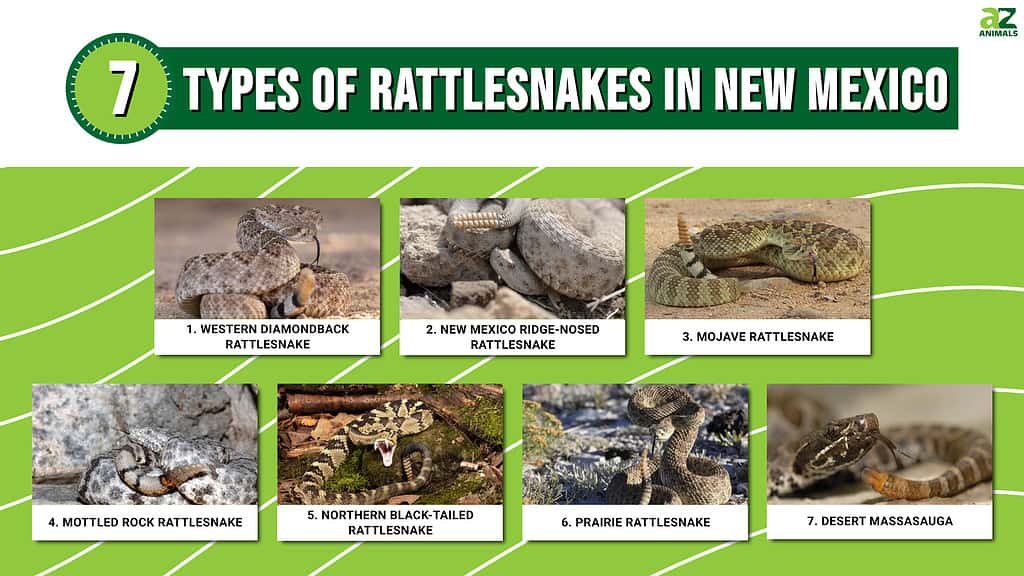
Snakes get a bad reputation in New Mexico, partially because there are so many living throughout the state — at least 46 species! Fortunately, only eight of the 46 species of New Mexico’s snakes are venomous, seven of which are rattlesnakes. Five out of seven of these rattlesnakes only live in southern portions of the state. Although rattlesnakes are venomous and can be dangerous, they are also vital to the ecosystems of New Mexico.
By learning more about these snakes we can develop a deeper understanding and respect for these reptiles, which helps us coexist safely.
So, which species of rattlesnake live in New Mexico?
1. Western Diamondback Rattlesnake

The western diamondback rattlesnake has very distinct black and white bands along the end of its tail.
©Alexander Wong/Shutterstock.com
The western diamondback rattlesnake is widespread throughout New Mexico and is one of the most common rattlesnakes in the state. Its habitat stretches across the southwestern United States and northern Mexico. These snakes are aggressive, unlike many of the other snakes on this list. In fact, the Western diamondback rattlesnake may be the most aggressive of all rattlesnakes, choosing to stand its ground rather than hide or flee. Its venom is mostly hemotoxic and attacks red blood cells.
Western diamondback rattlesnakes are the largest rattlesnakes in New Mexico, measuring 4-6 feet long, and can live for over 20 years. They are mostly gray with darker diamond patterns running along the length of their bodies. These diamond markings are outlined in white or yellow. Many of the western diamondback rattlesnakes in New Mexico have pink and red tones as well. One of the most distinctive features of the Western diamondback rattlesnake is the bold black and white rings on the end of its tail just before the rattle. Sometimes it is called the “Coon-Tail Rattlesnake” because of this unique feature.
2. New Mexico Ridge-Nosed Rattlesnake
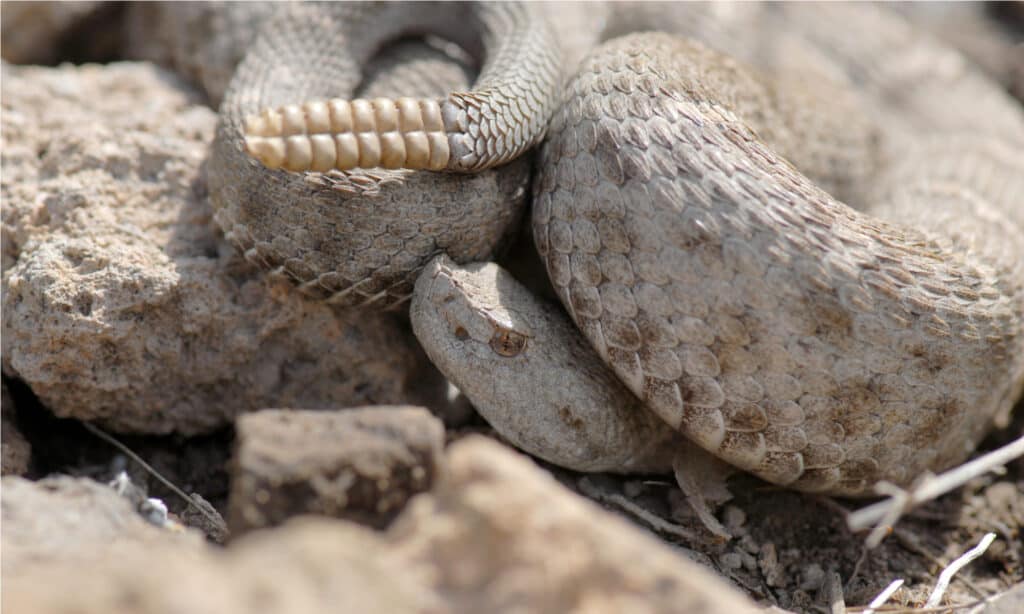
State laws protect the New Mexico ridge-nosed rattlesnake, or the animas ridge-nosed rattlesnake.
©Rusty Dodson/Shutterstock.com
The New Mexico ridge-nosed rattlesnake lives in the southeast of New Mexico. This snake has a very limited range, from extreme southeast Arizona down to small portions of Chihuahua and Sonora, Mexico. It is a subspecies of the ridge-nosed rattlesnake and grows to be 20-24 inches long and has a lifespan of 21 years. Because of its limited range and its appeal to reptile collectors, the New Mexico ridge-nosed rattlesnake is an endangered species. State laws protect this species.
New Mexico ridge-nosed rattlesnakes generally have a dull coloring that helps them blend into their environment. These snakes are gray, sandy-gray, reddish-gray, or brownish gray, with light-colored bands and small brown spots scattered across their slender bodies. Like all ridge-nosed rattlesnakes, the New Mexico ridge-nosed rattlesnake has a distinct ridge along the sides of its nose, created by a series of upturned scales. Some snakes may have extremely faded white stripes across the face as well.
The New Mexico ridge-nosed rattlesnake eats small mammals, birds, and lizards. It often hides in leaf litter while waiting to ambush its prey. This snake will also climb trees and bushes for a better view to locate its prey.
3. Mojave Rattlesnake

The Mojave rattlesnake is the most deadly snake in the United States.
©Creeping Things/Shutterstock.com
The Mojave rattlesnake lives in the extreme southern portion of New Mexico. Its habitat also stretches from central Mexico through the southwest United States. The Mojave rattlesnake is 39-54 inches long and lives in desert climates with little vegetation where it spends much of its time out in the open air.
The Mojave rattlesnake comes in various shades of brown (often with a greenish hue), olive green, or greenish gray. The Western rattlesnake has a similar appearance, but it lacks this “Mojave” green shading. The Mojave rattlesnake has a dark diamond pattern running down the middle of its back, with a white band on its tail. It lives for about 12.5 years in total.
The venom of the Mojave rattlesnake is one of the most dangerous in North America. However, anti-venom can treat bites if victims seek medical treatment right away. The Mojave rattlesnake’s potent venom is a neurotoxic-hemotoxic blend, attacking both the nervous system and the circulatory system at the same time.
4. Mottled Rock Rattlesnake
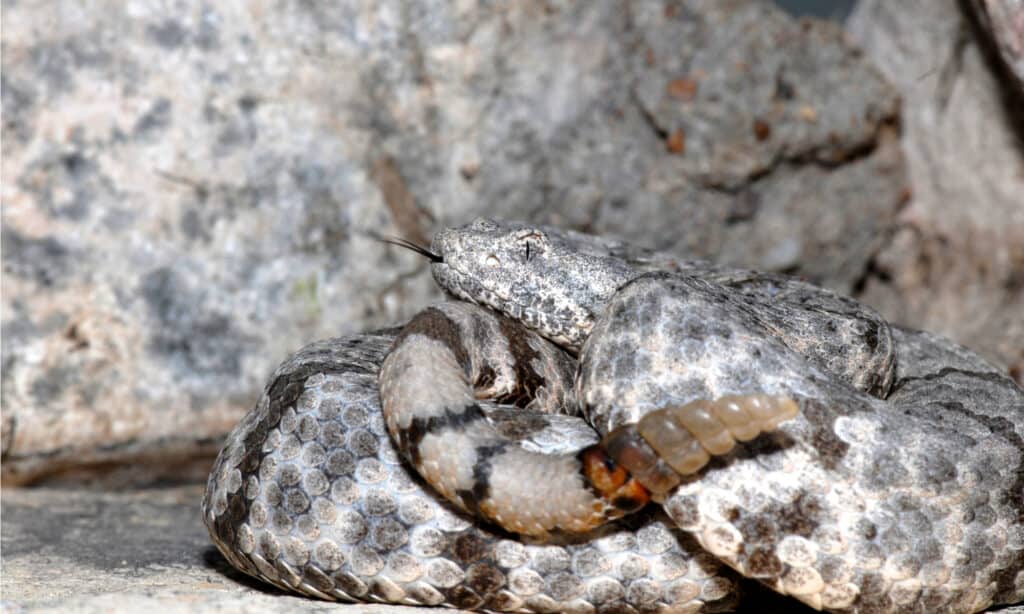
Mottled rock rattlesnakes blend in easily with the rocks around them due to their mottled camouflage.
©Rusty Dodson/Shutterstock.com
The mottled rock rattlesnake lives in the far southeast corner of New Mexico. Its habitat also extends to other mountain and rocky regions in the southwest United States. This snake is a subspecies of the rock rattlesnake. It is usually less than 32 inches long, although it can be anywhere from 1 ½ feet to 3 feet long. The mottled rock rattlesnake’s color varies depending on location. Rattlesnakes living in areas with limestone will be a light gray color, while snakes living in higher altitudes tend to be darker, and some are even pink. This snake has dark bands along the length of its body. Sometimes it also has additional small splotches scattered across its body, giving it a “mottled” look.
The mottled rock rattlesnake is not very aggressive. It doesn’t rattle its tail as a warning unless a threat is very close. This snake is generally docile and prefers to avoid large animals and humans by blending into the surrounding environment. However, it is still a dangerous rattlesnake with a potent hemotoxic venom. Like the banded rock rattlesnake, the mottled rock rattlesnake is protected by New Mexico state laws.
5. Northern Black-Tailed Rattlesnake
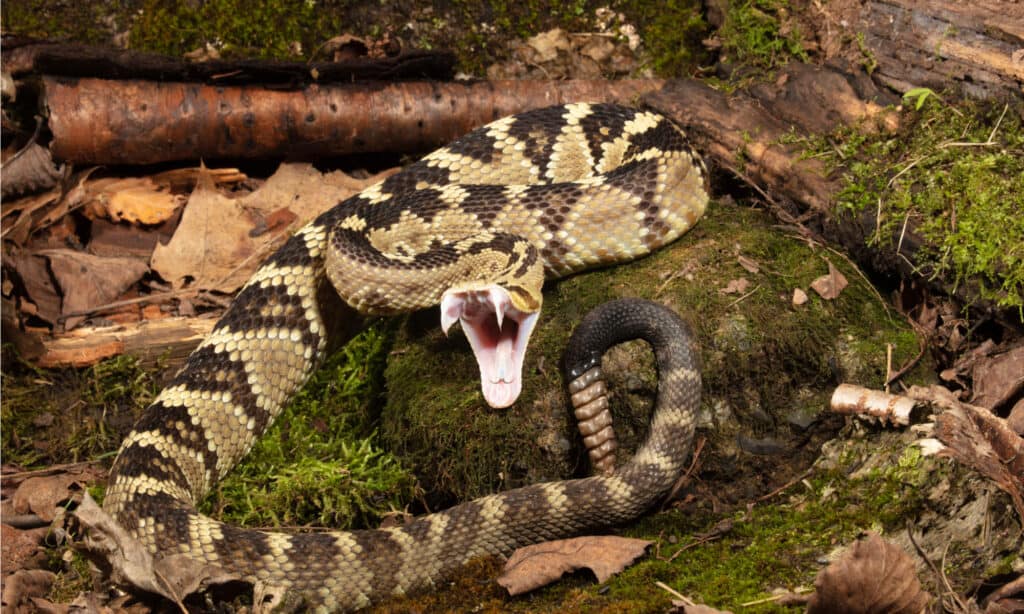
The black-tailed rattlesnake is sometimes called the “dog-faced rattlesnake.”
©Joe McDonald/Shutterstock.com
The northern black-tailed rattlesnake lives in the mountains and low deserts of southwest and central New Mexico. Its habitat stretches across the southwestern United States and Mexico. This snake is a subspecies of black-tailed rattlesnake and is 24-48 inches long. It has a lifespan of 25 – 20 years.
Northern black-tailed rattlesnakes come in many different colors like greenish-yellow, olive-gray, yellowish, reddish-brown, and black. They have a dark-colored band across their eyes, making it look like they are wearing a mask. Dark diamond-shaped bands run along the top of the snake’s back down to its tail. Like its name, the northern black-tailed rattlesnake has a dark gray or black tail.
6. Prairie Rattlesnake
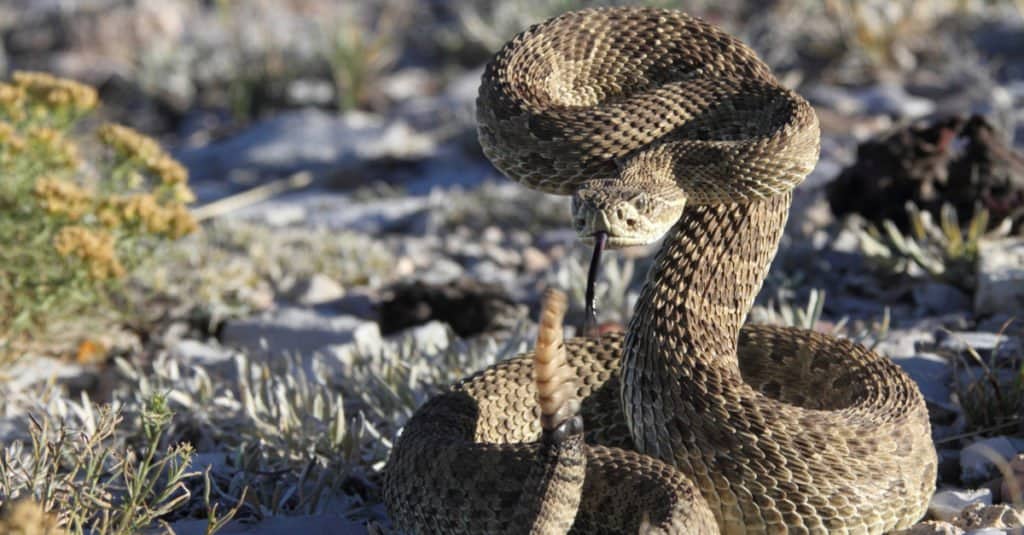
Prairie rattlesnakes spend most of their time slithering on the ground, but they can also climb trees.
©Harris Motion Photo/Shutterstock.com
The prairie rattlesnake lives all throughout New Mexico. These snakes are 36-54 inches in length with light-colored bodies. Prairie rattlesnakes typically have a brown, gray, or green base color, with brown blotches along their backs. These dark blotches have thick white borders and an oval-like shape. Toward the tail, there are dark rings instead of blotches. Prairie rattlesnakes have keeled or ridged scales that give their bodies a rough, desert-like texture and have a lifespan of 16 – 20 years.
The prairie rattlesnake has a hemotoxin venom that attacks blood cells and the circulatory system. Its venom also has neurotoxins that attack the nervous system, causing paralysis. These snakes typically eat small mammals like mice, rats, ground squirrels, prairie dogs, and small rabbits. However, they do occasionally eat amphibians, small reptiles, and ground-nesting birds.
7. Desert Massasauga
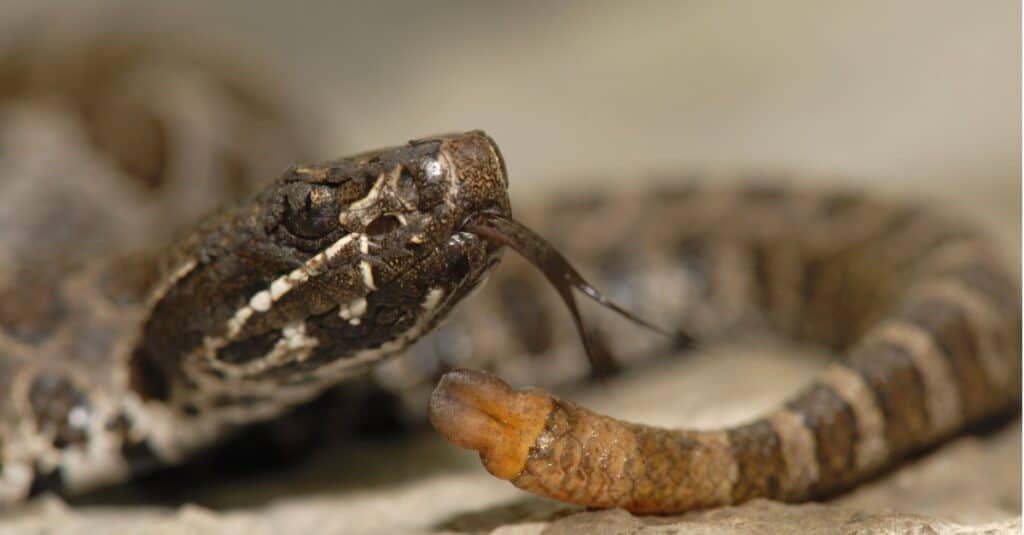
The desert massasauga rattlesnake is the smallest of the three subspecies of massasauga snakes.
©iStock.com/Shoemcfly
The desert massasauga lives in southern New Mexico, as well as across the southwestern United States and northern Mexico. It is a smaller rattlesnake, usually around 18 inches long. It is sandy (usually tan or gray), and has large, brown blotches close together down the middle of its back. The desert massasauga has a dark brown stripe along its cheek on both sides of the face, from the eye to the back corner of the mouth. There is also a very narrow white line just below this dark cheek stripe.
The desert massasauga is not an aggressive rattlesnake. These snakes are shy and generally prefer to slither away from threats and danger rather than defend or attack. The desert massasauga’s rattle is smaller and sounds more like crickets rather than the usually strong warning sound of a larger rattlesnake. Although experts aren’t quite sure how long it lives on its own out in the wild, they have found this rattlesnake can live for as long as 20 years under expert care and supervision.
Summary
Overall, about 100 rattlesnake bites are reported annually in New Mexico. Luckily, deaths from these bites are rare.
The most common to look out for are the western diamondback and the prairie rattlers, as they are most widespread throughout the state.
Below is a summary of New Mexico rattlesnake species:
| Index | Species | Size | Location |
| 1 | Western diamondback rattlesnake | 4-6 feet | Southwestern United States and Northern Mexico |
| 2 | New Mexico ridge-nose rattlesnake | 20-24 inches | Southeast of New Mexico |
| 3 | Mojave rattlesnake | 39 – 54 inches | Southern New Mexico, from the southwest United States to central Mexico |
| 4 | Mottled rock rattlesnake | 30 inches – 3 feet | Southeastern New Mexico |
| 5 | Northern black-tailed rattlesnake | 24-48 inches long | Southwestern United States and Mexico. |
| 6 | Prairie rattlesnake | 36-54 inches | Throughout New Mexico |
| 7 | Desert Massasauga | 18 inches | Southern New Mexico, Southwestern United States, and northern Mexico. |
Other Snakes Found In New Mexico
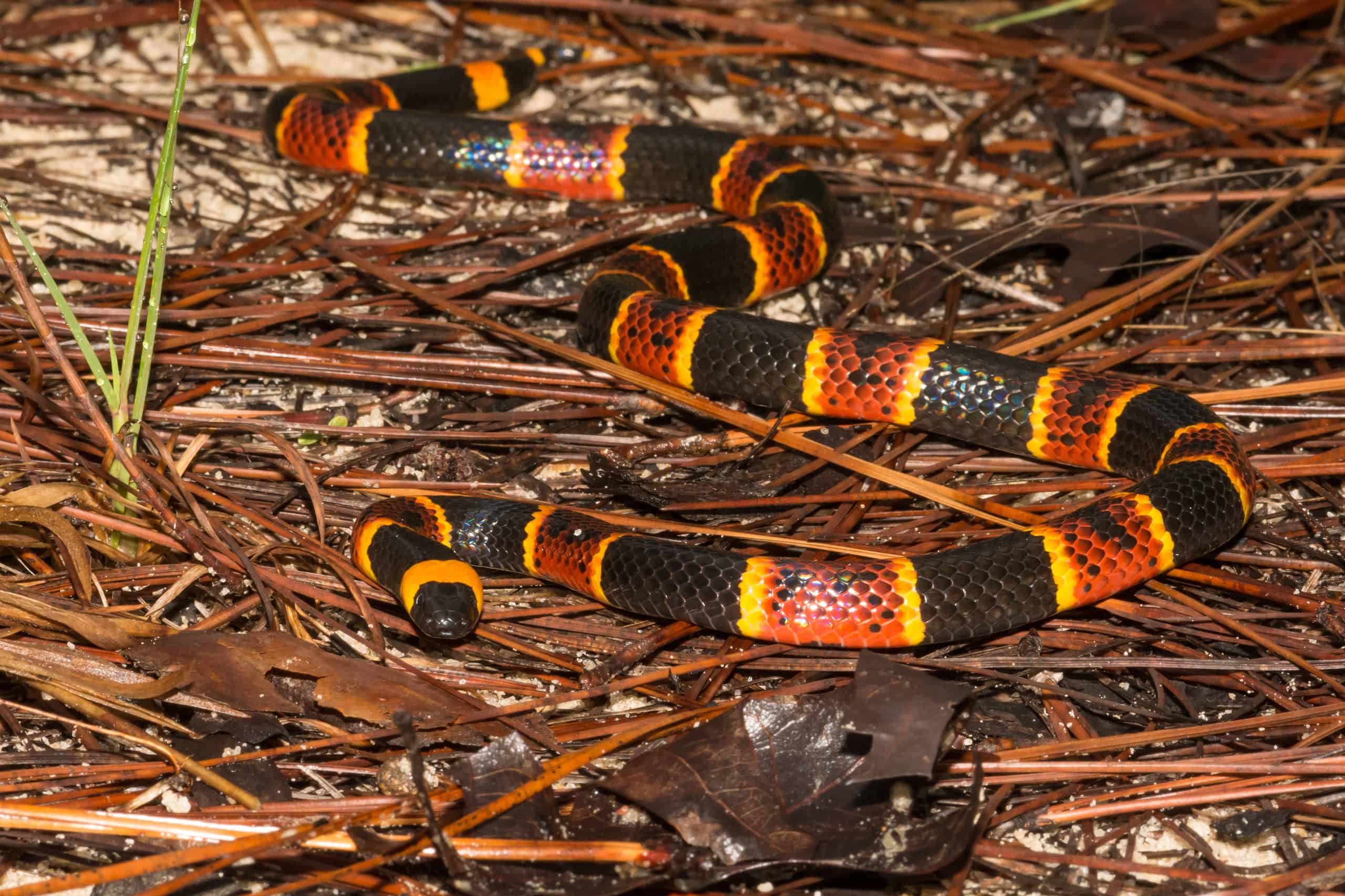
Coral Snakes have highly toxic venom and should be avoided.
©Jay Ondreicka/Shutterstock.com
The coral snake is a small, brightly patterned venomous snake of which there are more than 100 species, separated into the old world and new world snakes. The coral snake belongs to the cobra family, of which only two species live in the United States – the Arizona coral snake and the eastern coral snake. While the snakes in this area are quite small and not likely to inflict much damage on a human, they still have highly toxic venom.
To help differentiate it from the look-a-like non-venomous New Mexico milk snake, there are various color rhymes like these: “Red on yellow, kill a fellow, red on black, venom lack” and “Red and yellow can kill a fellow; Red and black, a friend of Jack”.
The photo featured at the top of this post is ©
Discover the "Monster" Snake 5X Bigger than an Anaconda
Every day A-Z Animals sends out some of the most incredible facts in the world from our free newsletter. Want to discover the 10 most beautiful snakes in the world, a "snake island" where you're never more than 3 feet from danger, or a "monster" snake 5X larger than an anaconda? Then sign up right now and you'll start receiving our daily newsletter absolutely free.
Thank you for reading! Have some feedback for us? Contact the AZ Animals editorial team.







